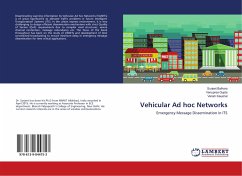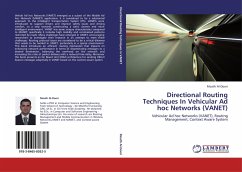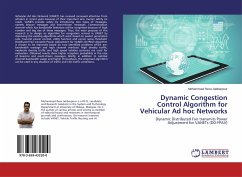Leila Benarous, Salim Batim, Abdelhamid Mellouk
Security in Vehicular Networks
Focus on Location and Identity Privacy
Leila Benarous, Salim Batim, Abdelhamid Mellouk
Security in Vehicular Networks
Focus on Location and Identity Privacy
- Gebundenes Buch
- Merkliste
- Auf die Merkliste
- Bewerten Bewerten
- Teilen
- Produkt teilen
- Produkterinnerung
- Produkterinnerung
Vehicular networks were first developed to ensure safe driving and to extend the Internet to the road. However, we can now see that the ability of vehicles to engage in cyber-activity may result in tracking and privacy violations through the interception of messages, which are frequently exchanged on road. This book serves as a guide for students, developers and researchers who are interested in vehicular networks and the associated security and privacy issues. It facilitates the understanding of the technologies used and their various types, highlighting the importance of privacy and security…mehr
Andere Kunden interessierten sich auch für
![Security and Privacy in Vehicular Ad hoc Networks Security and Privacy in Vehicular Ad hoc Networks]() Subir BiswasSecurity and Privacy in Vehicular Ad hoc Networks36,99 €
Subir BiswasSecurity and Privacy in Vehicular Ad hoc Networks36,99 €![SECURITY IN VEHICULAR ADHOC NETWORKS SECURITY IN VEHICULAR ADHOC NETWORKS]() Reema SandhuSECURITY IN VEHICULAR ADHOC NETWORKS29,99 €
Reema SandhuSECURITY IN VEHICULAR ADHOC NETWORKS29,99 €![Vehicular Ad hoc Networks Vehicular Ad hoc Networks]() Surjeet BalharaVehicular Ad hoc Networks33,99 €
Surjeet BalharaVehicular Ad hoc Networks33,99 €![Directional Routing Techniques In Vehicular Ad hoc Networks (VANET) Directional Routing Techniques In Vehicular Ad hoc Networks (VANET)]() Moath Al-DooriDirectional Routing Techniques In Vehicular Ad hoc Networks (VANET)51,99 €
Moath Al-DooriDirectional Routing Techniques In Vehicular Ad hoc Networks (VANET)51,99 €![Roadside Networks for Vehicular Communications Roadside Networks for Vehicular Communications]() Roadside Networks for Vehicular Communications175,99 €
Roadside Networks for Vehicular Communications175,99 €![Dynamic Congestion Control Algorithm for Vehicular Ad hoc Networks Dynamic Congestion Control Algorithm for Vehicular Ad hoc Networks]() Mohammad Reza JabbarpourDynamic Congestion Control Algorithm for Vehicular Ad hoc Networks26,99 €
Mohammad Reza JabbarpourDynamic Congestion Control Algorithm for Vehicular Ad hoc Networks26,99 €![Studies on Urban Vehicular Ad-hoc Networks Studies on Urban Vehicular Ad-hoc Networks]() Hongzi ZhuStudies on Urban Vehicular Ad-hoc Networks38,99 €
Hongzi ZhuStudies on Urban Vehicular Ad-hoc Networks38,99 €-
-
-
Vehicular networks were first developed to ensure safe driving and to extend the Internet to the road. However, we can now see that the ability of vehicles to engage in cyber-activity may result in tracking and privacy violations through the interception of messages, which are frequently exchanged on road. This book serves as a guide for students, developers and researchers who are interested in vehicular networks and the associated security and privacy issues. It facilitates the understanding of the technologies used and their various types, highlighting the importance of privacy and security issues and the direct impact they have on the safety of their users. It also explains various solutions and proposals to protect location and identity privacy, including two anonymous authentication methods that preserve identity privacy and a total of five schemes that preserve location privacy in the vehicular ad hoc networks and the cloud-enabled internet of vehicles, respectively.
Produktdetails
- Produktdetails
- Verlag: Wiley
- Seitenzahl: 272
- Erscheinungstermin: 11. Oktober 2022
- Englisch
- Abmessung: 240mm x 161mm x 19mm
- Gewicht: 566g
- ISBN-13: 9781786308481
- ISBN-10: 1786308487
- Artikelnr.: 65342006
- Herstellerkennzeichnung
- Libri GmbH
- Europaallee 1
- 36244 Bad Hersfeld
- gpsr@libri.de
- Verlag: Wiley
- Seitenzahl: 272
- Erscheinungstermin: 11. Oktober 2022
- Englisch
- Abmessung: 240mm x 161mm x 19mm
- Gewicht: 566g
- ISBN-13: 9781786308481
- ISBN-10: 1786308487
- Artikelnr.: 65342006
- Herstellerkennzeichnung
- Libri GmbH
- Europaallee 1
- 36244 Bad Hersfeld
- gpsr@libri.de
Leila Benarous is an associate professor in the Computer Science department and a researcher at LIM Laboratory, University of Laghouat, Algeria. She is also an associate member of UPEC-LiSSi-TincNET Research Team, France. Salim Bitam is a professor of Computer Science and vice rector responsible for post-graduation training and scientific research at the University of Biskra, Algeria. His main research interests include vehicular networks, cloud computing and bio-inspired methods. Abdelhamid Mellouk is currently the director of IT4H High School Engineering Department, a professor at the University of Paris-Est Créteil (UPEC) and Head of UPEC-LiSSi-TincNET Research Team, France. He is the founder of the Network Control Research and Curricula activities in UPEC, the current co President of the French Deep Tech Data Science and Artificial Intelligence Systematic Hub, member of the Algerian High Research Council (CNRST) and an associate editor of several top ranking scientific journals.
Preface xi
List of Acronyms xiii
Introduction xix
Chapter 1 Vehicular Networks 1
1.1 Introduction 1
1.2 Motivation by numbers 2
1.3 Evolution 3
1.4 Architecture 4
1.5 Characteristics 5
1.6 Technical challenges and issues 6
1.7 Wireless technology 7
1.8 Standards 7
1.8.1 IEEE WAVE stack 8
1.8.2 ETSI standards 9
1.8.3 The 3GPP standard 9
1.9 Types 10
1.9.1 The autonomous vehicle (self-dependent) 10
1.9.2 VANET 11
1.9.3 Vehicular clouds 11
1.9.4 Internet of vehicles 12
1.9.5 Social Internet of vehicles 14
1.9.6 Data named vehicular networks 15
1.9.7 Software-defined vehicular networks 15
1.10 Test beds and real implementations 16
1.11 Services and applications 17
1.12 Public opinion 19
1.13 Conclusion 20
Chapter 2 Privacy and Security in Vehicular Networks 21
2.1 Introduction 21
2.2 Privacy issue in vehicular networks 22
2.2.1 Types 23
2.2.2 When and how it is threatened? 24
2.2.3 Who is the threat? 24
2.2.4 What are the consequences? 24
2.2.5 How can we protect against it? 25
2.3 State-of-the-art location privacy-preserving solutions 28
2.3.1 Non-cooperative change 28
2.3.2 Silence approaches 28
2.3.3 Infrastructure-based mix-zone approach 28
2.3.4 The cooperation approach (distributed mix-zone) 36
2.3.5 Hybrid approach 36
2.4 Authentication issues in vehicular networks 49
2.4.1 What is being authenticated in vehicular networks? 49
2.4.2 Authentication types 50
2.4.3 How does authentication risk privacy? 51
2.5 Identity privacy preservation authentication solutions: state of the
art 52
2.6 Conclusion 54
Chapter 3 Security and Privacy Evaluation Methodology 55
3.1 Introduction 55
3.2 Evaluation methodology 58
3.2.1 Security 58
3.2.2 Privacy 66
3.3 Conclusion 74
Chapter 4 The Attacker Model 75
4.1 Introduction 75
4.2 Security objectives 76
4.3 Security challenges 78
4.4 Security attacker 79
4.4.1 Aims 80
4.4.2 Types 80
4.4.3 Means 81
4.4.4 Attacks 82
Contents vii
4.4.5 Our attacker model 85
4.5 Conclusion 90
Chapter 5 Privacy-preserving Authentication in Cloud-enabled Vehicle Data
Named Networks (CVDNN) for Resources Sharing 91
5.1 Introduction 91
5.2 Background 92
5.2.1 Vehicular clouds 92
5.2.2 Vehicular data named networks 94
5.3 System description 94
5.4 Forming cloud-enabled vehicle data named networks 95
5.5 Migrating the local cloud virtual machine to the central cloud 97
5.6 Privacy and authentication when using/providing CVDNN services 97
5.6.1 The authentication process 98
5.6.2 The reputation testimony 100
5.7 The privacy in CVDNN 102
5.8 Discussion and analysis 103
5.8.1 The privacy when joining the VC 103
5.8.2 Privacy while using the VC 106
5.9 Conclusion 106
Chapter 6 Privacy-preserving Authentication Scheme for On-road On-demand
Refilling of Pseudonym in VANET 109
6.1 Introduction 109
6.2 Network model and system functionality 111
6.2.1 Network model 111
6.2.2 The system functionality 113
6.3 Proposed scheme 114
6.4 Analysis and discussion 119
6.4.1 Security analysis 119
6.4.2 Burrows, Abadi and Needham (BAN) logic 124
6.4.3 SPAN and AVISPA tools 126
6.5 Conclusion 129
Chapter 7 Preserving the Location Privacy of Vehicular Ad hoc Network Users
131
7.1 Introduction 131
7.2 Adversary model 133
7.3 Proposed camouflage-based location privacy-preserving scheme 133
7.3.1 Analytical model 135
7.3.2 Simulation 136
7.4 Proposed hybrid pseudonym change strategy 141
7.4.1 Hypothesis and assumptions 141
7.4.2 Changing the pseudonyms 142
7.4.3 The simulation 145
7.5 Conclusion 148
Chapter 8 Preserving the Location Privacy of Internet of Vehicles Users
151
8.1 Introduction 151
8.2 CE-IoV 153
8.3 Privacy challenges 156
8.4 Attacker model 157
8.5 CLPPS: cooperative-based location privacy-preserving scheme for
Internet of vehicles 158
8.5.1 Simulation 159
8.5.2 Comparative study and performance analysis 163
8.6 CSLPPS: concerted silence-based location privacy-preserving scheme for
Internet of vehicles 166
8.6.1 The proposed solution 166
8.6.2 Simulation results 167
8.6.3 Comparative study performance analysis 169
8.7 Obfuscation-based location privacy-preserving scheme in cloud-enabled
Internet of vehicles 171
8.7.1 The proposition 171
8.7.2 Study of feasibility using game theoretic approach 173
8.7.3 The simulation 174
8.7.4 Analytical model 177
8.7.5 Comparative study 178
8.8 Conclusion 180
Chapter 9 Blockchain-based Privacy-aware Pseudonym Management Framework for
Vehicular Networks 181
9.1 Introduction 181
9.2 Background 183
9.2.1 Public key infrastructure (PKI) 183
9.2.2 Vehicular PKI 185
9.2.3 Blockchain technology 185
9.2.4 Blockchain of blockchains 190
9.3 Related works 191
9.3.1 Blockchain-based PKI 191
9.3.2 Privacy-aware blockchain-based PKI 191
9.3.3 Monero 191
9.3.4 Blockchain-based vehicular PKI 192
9.4 Key concepts 192
9.4.1 Ring signature 192
9.4.2 One-time address 194
9.5 Proposed solution 195
9.5.1 General description 195
9.5.2 Registration to the blockchain 196
9.5.3 Certifying process 196
9.5.4 Revocation process 197
9.5.5 Transaction structure and validation 197
9.5.6 Block structure and validation 200
9.5.7 Authentication using blockchain 201
9.6 Analysis 202
9.7 Comparative study 206
9.8 Conclusion 206
Conclusion 211
References 215
Index 229
List of Acronyms xiii
Introduction xix
Chapter 1 Vehicular Networks 1
1.1 Introduction 1
1.2 Motivation by numbers 2
1.3 Evolution 3
1.4 Architecture 4
1.5 Characteristics 5
1.6 Technical challenges and issues 6
1.7 Wireless technology 7
1.8 Standards 7
1.8.1 IEEE WAVE stack 8
1.8.2 ETSI standards 9
1.8.3 The 3GPP standard 9
1.9 Types 10
1.9.1 The autonomous vehicle (self-dependent) 10
1.9.2 VANET 11
1.9.3 Vehicular clouds 11
1.9.4 Internet of vehicles 12
1.9.5 Social Internet of vehicles 14
1.9.6 Data named vehicular networks 15
1.9.7 Software-defined vehicular networks 15
1.10 Test beds and real implementations 16
1.11 Services and applications 17
1.12 Public opinion 19
1.13 Conclusion 20
Chapter 2 Privacy and Security in Vehicular Networks 21
2.1 Introduction 21
2.2 Privacy issue in vehicular networks 22
2.2.1 Types 23
2.2.2 When and how it is threatened? 24
2.2.3 Who is the threat? 24
2.2.4 What are the consequences? 24
2.2.5 How can we protect against it? 25
2.3 State-of-the-art location privacy-preserving solutions 28
2.3.1 Non-cooperative change 28
2.3.2 Silence approaches 28
2.3.3 Infrastructure-based mix-zone approach 28
2.3.4 The cooperation approach (distributed mix-zone) 36
2.3.5 Hybrid approach 36
2.4 Authentication issues in vehicular networks 49
2.4.1 What is being authenticated in vehicular networks? 49
2.4.2 Authentication types 50
2.4.3 How does authentication risk privacy? 51
2.5 Identity privacy preservation authentication solutions: state of the
art 52
2.6 Conclusion 54
Chapter 3 Security and Privacy Evaluation Methodology 55
3.1 Introduction 55
3.2 Evaluation methodology 58
3.2.1 Security 58
3.2.2 Privacy 66
3.3 Conclusion 74
Chapter 4 The Attacker Model 75
4.1 Introduction 75
4.2 Security objectives 76
4.3 Security challenges 78
4.4 Security attacker 79
4.4.1 Aims 80
4.4.2 Types 80
4.4.3 Means 81
4.4.4 Attacks 82
Contents vii
4.4.5 Our attacker model 85
4.5 Conclusion 90
Chapter 5 Privacy-preserving Authentication in Cloud-enabled Vehicle Data
Named Networks (CVDNN) for Resources Sharing 91
5.1 Introduction 91
5.2 Background 92
5.2.1 Vehicular clouds 92
5.2.2 Vehicular data named networks 94
5.3 System description 94
5.4 Forming cloud-enabled vehicle data named networks 95
5.5 Migrating the local cloud virtual machine to the central cloud 97
5.6 Privacy and authentication when using/providing CVDNN services 97
5.6.1 The authentication process 98
5.6.2 The reputation testimony 100
5.7 The privacy in CVDNN 102
5.8 Discussion and analysis 103
5.8.1 The privacy when joining the VC 103
5.8.2 Privacy while using the VC 106
5.9 Conclusion 106
Chapter 6 Privacy-preserving Authentication Scheme for On-road On-demand
Refilling of Pseudonym in VANET 109
6.1 Introduction 109
6.2 Network model and system functionality 111
6.2.1 Network model 111
6.2.2 The system functionality 113
6.3 Proposed scheme 114
6.4 Analysis and discussion 119
6.4.1 Security analysis 119
6.4.2 Burrows, Abadi and Needham (BAN) logic 124
6.4.3 SPAN and AVISPA tools 126
6.5 Conclusion 129
Chapter 7 Preserving the Location Privacy of Vehicular Ad hoc Network Users
131
7.1 Introduction 131
7.2 Adversary model 133
7.3 Proposed camouflage-based location privacy-preserving scheme 133
7.3.1 Analytical model 135
7.3.2 Simulation 136
7.4 Proposed hybrid pseudonym change strategy 141
7.4.1 Hypothesis and assumptions 141
7.4.2 Changing the pseudonyms 142
7.4.3 The simulation 145
7.5 Conclusion 148
Chapter 8 Preserving the Location Privacy of Internet of Vehicles Users
151
8.1 Introduction 151
8.2 CE-IoV 153
8.3 Privacy challenges 156
8.4 Attacker model 157
8.5 CLPPS: cooperative-based location privacy-preserving scheme for
Internet of vehicles 158
8.5.1 Simulation 159
8.5.2 Comparative study and performance analysis 163
8.6 CSLPPS: concerted silence-based location privacy-preserving scheme for
Internet of vehicles 166
8.6.1 The proposed solution 166
8.6.2 Simulation results 167
8.6.3 Comparative study performance analysis 169
8.7 Obfuscation-based location privacy-preserving scheme in cloud-enabled
Internet of vehicles 171
8.7.1 The proposition 171
8.7.2 Study of feasibility using game theoretic approach 173
8.7.3 The simulation 174
8.7.4 Analytical model 177
8.7.5 Comparative study 178
8.8 Conclusion 180
Chapter 9 Blockchain-based Privacy-aware Pseudonym Management Framework for
Vehicular Networks 181
9.1 Introduction 181
9.2 Background 183
9.2.1 Public key infrastructure (PKI) 183
9.2.2 Vehicular PKI 185
9.2.3 Blockchain technology 185
9.2.4 Blockchain of blockchains 190
9.3 Related works 191
9.3.1 Blockchain-based PKI 191
9.3.2 Privacy-aware blockchain-based PKI 191
9.3.3 Monero 191
9.3.4 Blockchain-based vehicular PKI 192
9.4 Key concepts 192
9.4.1 Ring signature 192
9.4.2 One-time address 194
9.5 Proposed solution 195
9.5.1 General description 195
9.5.2 Registration to the blockchain 196
9.5.3 Certifying process 196
9.5.4 Revocation process 197
9.5.5 Transaction structure and validation 197
9.5.6 Block structure and validation 200
9.5.7 Authentication using blockchain 201
9.6 Analysis 202
9.7 Comparative study 206
9.8 Conclusion 206
Conclusion 211
References 215
Index 229
Preface xi
List of Acronyms xiii
Introduction xix
Chapter 1 Vehicular Networks 1
1.1 Introduction 1
1.2 Motivation by numbers 2
1.3 Evolution 3
1.4 Architecture 4
1.5 Characteristics 5
1.6 Technical challenges and issues 6
1.7 Wireless technology 7
1.8 Standards 7
1.8.1 IEEE WAVE stack 8
1.8.2 ETSI standards 9
1.8.3 The 3GPP standard 9
1.9 Types 10
1.9.1 The autonomous vehicle (self-dependent) 10
1.9.2 VANET 11
1.9.3 Vehicular clouds 11
1.9.4 Internet of vehicles 12
1.9.5 Social Internet of vehicles 14
1.9.6 Data named vehicular networks 15
1.9.7 Software-defined vehicular networks 15
1.10 Test beds and real implementations 16
1.11 Services and applications 17
1.12 Public opinion 19
1.13 Conclusion 20
Chapter 2 Privacy and Security in Vehicular Networks 21
2.1 Introduction 21
2.2 Privacy issue in vehicular networks 22
2.2.1 Types 23
2.2.2 When and how it is threatened? 24
2.2.3 Who is the threat? 24
2.2.4 What are the consequences? 24
2.2.5 How can we protect against it? 25
2.3 State-of-the-art location privacy-preserving solutions 28
2.3.1 Non-cooperative change 28
2.3.2 Silence approaches 28
2.3.3 Infrastructure-based mix-zone approach 28
2.3.4 The cooperation approach (distributed mix-zone) 36
2.3.5 Hybrid approach 36
2.4 Authentication issues in vehicular networks 49
2.4.1 What is being authenticated in vehicular networks? 49
2.4.2 Authentication types 50
2.4.3 How does authentication risk privacy? 51
2.5 Identity privacy preservation authentication solutions: state of the
art 52
2.6 Conclusion 54
Chapter 3 Security and Privacy Evaluation Methodology 55
3.1 Introduction 55
3.2 Evaluation methodology 58
3.2.1 Security 58
3.2.2 Privacy 66
3.3 Conclusion 74
Chapter 4 The Attacker Model 75
4.1 Introduction 75
4.2 Security objectives 76
4.3 Security challenges 78
4.4 Security attacker 79
4.4.1 Aims 80
4.4.2 Types 80
4.4.3 Means 81
4.4.4 Attacks 82
Contents vii
4.4.5 Our attacker model 85
4.5 Conclusion 90
Chapter 5 Privacy-preserving Authentication in Cloud-enabled Vehicle Data
Named Networks (CVDNN) for Resources Sharing 91
5.1 Introduction 91
5.2 Background 92
5.2.1 Vehicular clouds 92
5.2.2 Vehicular data named networks 94
5.3 System description 94
5.4 Forming cloud-enabled vehicle data named networks 95
5.5 Migrating the local cloud virtual machine to the central cloud 97
5.6 Privacy and authentication when using/providing CVDNN services 97
5.6.1 The authentication process 98
5.6.2 The reputation testimony 100
5.7 The privacy in CVDNN 102
5.8 Discussion and analysis 103
5.8.1 The privacy when joining the VC 103
5.8.2 Privacy while using the VC 106
5.9 Conclusion 106
Chapter 6 Privacy-preserving Authentication Scheme for On-road On-demand
Refilling of Pseudonym in VANET 109
6.1 Introduction 109
6.2 Network model and system functionality 111
6.2.1 Network model 111
6.2.2 The system functionality 113
6.3 Proposed scheme 114
6.4 Analysis and discussion 119
6.4.1 Security analysis 119
6.4.2 Burrows, Abadi and Needham (BAN) logic 124
6.4.3 SPAN and AVISPA tools 126
6.5 Conclusion 129
Chapter 7 Preserving the Location Privacy of Vehicular Ad hoc Network Users
131
7.1 Introduction 131
7.2 Adversary model 133
7.3 Proposed camouflage-based location privacy-preserving scheme 133
7.3.1 Analytical model 135
7.3.2 Simulation 136
7.4 Proposed hybrid pseudonym change strategy 141
7.4.1 Hypothesis and assumptions 141
7.4.2 Changing the pseudonyms 142
7.4.3 The simulation 145
7.5 Conclusion 148
Chapter 8 Preserving the Location Privacy of Internet of Vehicles Users
151
8.1 Introduction 151
8.2 CE-IoV 153
8.3 Privacy challenges 156
8.4 Attacker model 157
8.5 CLPPS: cooperative-based location privacy-preserving scheme for
Internet of vehicles 158
8.5.1 Simulation 159
8.5.2 Comparative study and performance analysis 163
8.6 CSLPPS: concerted silence-based location privacy-preserving scheme for
Internet of vehicles 166
8.6.1 The proposed solution 166
8.6.2 Simulation results 167
8.6.3 Comparative study performance analysis 169
8.7 Obfuscation-based location privacy-preserving scheme in cloud-enabled
Internet of vehicles 171
8.7.1 The proposition 171
8.7.2 Study of feasibility using game theoretic approach 173
8.7.3 The simulation 174
8.7.4 Analytical model 177
8.7.5 Comparative study 178
8.8 Conclusion 180
Chapter 9 Blockchain-based Privacy-aware Pseudonym Management Framework for
Vehicular Networks 181
9.1 Introduction 181
9.2 Background 183
9.2.1 Public key infrastructure (PKI) 183
9.2.2 Vehicular PKI 185
9.2.3 Blockchain technology 185
9.2.4 Blockchain of blockchains 190
9.3 Related works 191
9.3.1 Blockchain-based PKI 191
9.3.2 Privacy-aware blockchain-based PKI 191
9.3.3 Monero 191
9.3.4 Blockchain-based vehicular PKI 192
9.4 Key concepts 192
9.4.1 Ring signature 192
9.4.2 One-time address 194
9.5 Proposed solution 195
9.5.1 General description 195
9.5.2 Registration to the blockchain 196
9.5.3 Certifying process 196
9.5.4 Revocation process 197
9.5.5 Transaction structure and validation 197
9.5.6 Block structure and validation 200
9.5.7 Authentication using blockchain 201
9.6 Analysis 202
9.7 Comparative study 206
9.8 Conclusion 206
Conclusion 211
References 215
Index 229
List of Acronyms xiii
Introduction xix
Chapter 1 Vehicular Networks 1
1.1 Introduction 1
1.2 Motivation by numbers 2
1.3 Evolution 3
1.4 Architecture 4
1.5 Characteristics 5
1.6 Technical challenges and issues 6
1.7 Wireless technology 7
1.8 Standards 7
1.8.1 IEEE WAVE stack 8
1.8.2 ETSI standards 9
1.8.3 The 3GPP standard 9
1.9 Types 10
1.9.1 The autonomous vehicle (self-dependent) 10
1.9.2 VANET 11
1.9.3 Vehicular clouds 11
1.9.4 Internet of vehicles 12
1.9.5 Social Internet of vehicles 14
1.9.6 Data named vehicular networks 15
1.9.7 Software-defined vehicular networks 15
1.10 Test beds and real implementations 16
1.11 Services and applications 17
1.12 Public opinion 19
1.13 Conclusion 20
Chapter 2 Privacy and Security in Vehicular Networks 21
2.1 Introduction 21
2.2 Privacy issue in vehicular networks 22
2.2.1 Types 23
2.2.2 When and how it is threatened? 24
2.2.3 Who is the threat? 24
2.2.4 What are the consequences? 24
2.2.5 How can we protect against it? 25
2.3 State-of-the-art location privacy-preserving solutions 28
2.3.1 Non-cooperative change 28
2.3.2 Silence approaches 28
2.3.3 Infrastructure-based mix-zone approach 28
2.3.4 The cooperation approach (distributed mix-zone) 36
2.3.5 Hybrid approach 36
2.4 Authentication issues in vehicular networks 49
2.4.1 What is being authenticated in vehicular networks? 49
2.4.2 Authentication types 50
2.4.3 How does authentication risk privacy? 51
2.5 Identity privacy preservation authentication solutions: state of the
art 52
2.6 Conclusion 54
Chapter 3 Security and Privacy Evaluation Methodology 55
3.1 Introduction 55
3.2 Evaluation methodology 58
3.2.1 Security 58
3.2.2 Privacy 66
3.3 Conclusion 74
Chapter 4 The Attacker Model 75
4.1 Introduction 75
4.2 Security objectives 76
4.3 Security challenges 78
4.4 Security attacker 79
4.4.1 Aims 80
4.4.2 Types 80
4.4.3 Means 81
4.4.4 Attacks 82
Contents vii
4.4.5 Our attacker model 85
4.5 Conclusion 90
Chapter 5 Privacy-preserving Authentication in Cloud-enabled Vehicle Data
Named Networks (CVDNN) for Resources Sharing 91
5.1 Introduction 91
5.2 Background 92
5.2.1 Vehicular clouds 92
5.2.2 Vehicular data named networks 94
5.3 System description 94
5.4 Forming cloud-enabled vehicle data named networks 95
5.5 Migrating the local cloud virtual machine to the central cloud 97
5.6 Privacy and authentication when using/providing CVDNN services 97
5.6.1 The authentication process 98
5.6.2 The reputation testimony 100
5.7 The privacy in CVDNN 102
5.8 Discussion and analysis 103
5.8.1 The privacy when joining the VC 103
5.8.2 Privacy while using the VC 106
5.9 Conclusion 106
Chapter 6 Privacy-preserving Authentication Scheme for On-road On-demand
Refilling of Pseudonym in VANET 109
6.1 Introduction 109
6.2 Network model and system functionality 111
6.2.1 Network model 111
6.2.2 The system functionality 113
6.3 Proposed scheme 114
6.4 Analysis and discussion 119
6.4.1 Security analysis 119
6.4.2 Burrows, Abadi and Needham (BAN) logic 124
6.4.3 SPAN and AVISPA tools 126
6.5 Conclusion 129
Chapter 7 Preserving the Location Privacy of Vehicular Ad hoc Network Users
131
7.1 Introduction 131
7.2 Adversary model 133
7.3 Proposed camouflage-based location privacy-preserving scheme 133
7.3.1 Analytical model 135
7.3.2 Simulation 136
7.4 Proposed hybrid pseudonym change strategy 141
7.4.1 Hypothesis and assumptions 141
7.4.2 Changing the pseudonyms 142
7.4.3 The simulation 145
7.5 Conclusion 148
Chapter 8 Preserving the Location Privacy of Internet of Vehicles Users
151
8.1 Introduction 151
8.2 CE-IoV 153
8.3 Privacy challenges 156
8.4 Attacker model 157
8.5 CLPPS: cooperative-based location privacy-preserving scheme for
Internet of vehicles 158
8.5.1 Simulation 159
8.5.2 Comparative study and performance analysis 163
8.6 CSLPPS: concerted silence-based location privacy-preserving scheme for
Internet of vehicles 166
8.6.1 The proposed solution 166
8.6.2 Simulation results 167
8.6.3 Comparative study performance analysis 169
8.7 Obfuscation-based location privacy-preserving scheme in cloud-enabled
Internet of vehicles 171
8.7.1 The proposition 171
8.7.2 Study of feasibility using game theoretic approach 173
8.7.3 The simulation 174
8.7.4 Analytical model 177
8.7.5 Comparative study 178
8.8 Conclusion 180
Chapter 9 Blockchain-based Privacy-aware Pseudonym Management Framework for
Vehicular Networks 181
9.1 Introduction 181
9.2 Background 183
9.2.1 Public key infrastructure (PKI) 183
9.2.2 Vehicular PKI 185
9.2.3 Blockchain technology 185
9.2.4 Blockchain of blockchains 190
9.3 Related works 191
9.3.1 Blockchain-based PKI 191
9.3.2 Privacy-aware blockchain-based PKI 191
9.3.3 Monero 191
9.3.4 Blockchain-based vehicular PKI 192
9.4 Key concepts 192
9.4.1 Ring signature 192
9.4.2 One-time address 194
9.5 Proposed solution 195
9.5.1 General description 195
9.5.2 Registration to the blockchain 196
9.5.3 Certifying process 196
9.5.4 Revocation process 197
9.5.5 Transaction structure and validation 197
9.5.6 Block structure and validation 200
9.5.7 Authentication using blockchain 201
9.6 Analysis 202
9.7 Comparative study 206
9.8 Conclusion 206
Conclusion 211
References 215
Index 229








